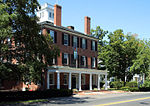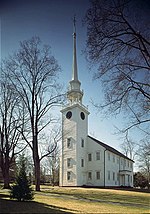Hill–Stead Museum
1901 establishments in ConnecticutArt museums and galleries in ConnecticutFormer private collections in the United StatesGardens in ConnecticutHistoric house museums in Connecticut ... and 10 more
Houses completed in 1901Houses in Farmington, ConnecticutHouses on the National Register of Historic Places in ConnecticutIndividually listed contributing properties to historic districts on the National Register in ConnecticutMetacomet Ridge, ConnecticutMuseums in Hartford County, ConnecticutMuseums on the National Register of Historic Places in ConnecticutNRHP infobox with nocatNational Historic Landmarks in ConnecticutNational Register of Historic Places in Hartford County, Connecticut

Hill–Stead Museum is a Colonial Revival house and art museum set on a large estate at 35 Mountain Road in Farmington, Connecticut. It is best known for its French Impressionist masterpieces, architecture, and stately grounds. The property was designated a National Historic Landmark as a nationally significant example of Colonial Revival architecture, built in 1901 to designs that were the result of a unique collaboration between Theodate Pope Riddle, one of the United States' first female architects, and the renowned firm of McKim, Mead & White. The house was built for Riddle's father, Alfred Atmore Pope, and the art collection it houses was collected by Pope and Riddle.
Excerpt from the Wikipedia article Hill–Stead Museum (License: CC BY-SA 3.0, Authors, Images).Hill–Stead Museum
Farmington Avenue,
Geographical coordinates (GPS) Address Nearby Places Show on map
Geographical coordinates (GPS)
| Latitude | Longitude |
|---|---|
| N 41.7222 ° | E -72.8189 ° |
Address
Hill-Stead Museum Grounds
Farmington Avenue
06032
Connecticut, United States
Open on Google Maps










